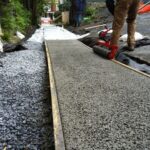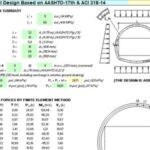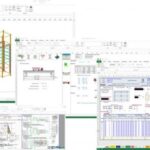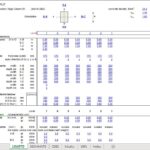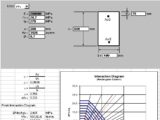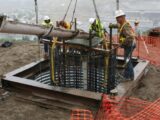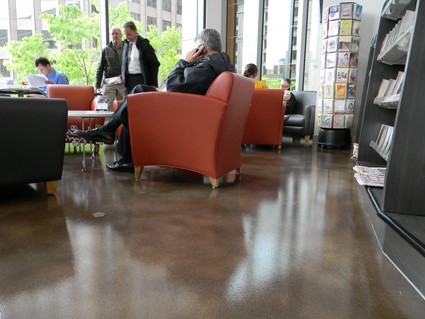
What is Self-Leveling Concrete? Properties, Advantages and Disadvantages
2 January 2022Table of Contents
What is Self-Leveling Concrete? Properties, Advantages and Disadvantages
1. Introduction
Self-leveling concrete is a polymer-modified high-performance concrete that has the ability to flow, compact, and provide a leveled surface when poured over an area. Self-leveling concrete does not require vibration as required for normal concrete.
It is poured in liquid form and goes down 1/4 to 1.5 inch thick in single pass. A gauging tool is used to spread it in place. Qualities include smoothness, flatness and a compressive strength over that of traditional concrete floors. After you apply it, you can add decorative overlays or concrete stains or dyes.
Self-leveling overlays are among the newest trends for architects and commercial property owners. It is quick to install and can be installed pre or post construction. It can cover plywood or tile floors as well, and is flood proof and hypoallergenic.
2. Properties of Self-Leveling Concrete (SLC)
- Low Plastic Viscosity.
- High Flow-ability.
- Low segregation.
- Low Bleeding.
- Stability.
a- Low Plastic Viscosity
The low plastic property of SLC increases the flow ability properties which imparts the self-leveling property. The balance and proportion of the above-mentioned properties in mix design help to design the desired SLC concrete.
b- High Flow-ability
Providing low viscosity of the concrete mix can result in stability issues. This can result in high segregation and bleeding problems. This low viscosity or high flow-ability is introduced by the addition of super plasticizes or polymer agents that maintain stability without affecting the flow-ability characteristics.
c- Stability
High-homogeneity is received by self-leveling concrete with its self-leveling property. The flow-ability properties of SLC are greater as compared with (SCC) self-compacting concrete. This increase in flow-ability is one reason to obtain good finish in final hardened SLC
d- Low segregation / Low Bleeding
The viscosity agents added prevents the settling down of aggregates that cause segregation and keep the cohesiveness of the mix within the bond which in turn helps in avoiding bleeding. Maintain the viscosity throughout the layer without letting the aggregates to settle at the bottom.
3. Advantages of Self-Leveling Concrete (SLC)
- Labor required less.
- Leveled and smooth surface.
- Water Resistant surface.
- SLC concrete gives a flat and smooth surface.
- The best choice of heavily reinforced concrete construction.
- The hardening of concrete is taking place in a homogeneous way.
- The best option where form-work is arranged in unusual geometry.
- Compressive strength is higher as compared to traditional concrete.
- Self-leveling concrete gives cohesive concrete that resits bleeding and segregation issues.
- Easy to use. Self-leveling concrete also levels the playing field. Now subfloor leveling is a DIY project.
- Two options to choose. Acrylic-based concrete is more giving, has a slight flex and sturdiness. Water-based concrete dries fast and is harder than standard concrete.
- Radiant heat capable. Most self-leveling concrete brands and styles are rated for using over around or under radiant floor heating systems.
- Quick acting. The formula that makes up the concrete compound is strong, durable and fast acting. It can set up in as little as 10 minutes and be ready for most flooring types in just a few hours.
- Hypoallergenic. Unlike standard concrete which has been known to cause work-induced asthma, self-leveling concrete doesn’t contain those chemicals and minerals.
- Mold and mildew resistant. Even when installed in wet areas, self-leveling concrete is more resistant to mold and mildew growth than standard concrete.
4. Disadvantages of Self-Leveling Concrete (SLC)
- Fast acting. Yes, this is also a pro item, but it dries fast. You shouldn’t mix until you are ready to pour, and when you pour you shouldn’t stop. Finding the right balance can be difficult.
- Doesn’t repair subfloors. If there is damage, cracks, joints or weak spots in your subfloor, self-leveling concrete will not fix or patch them. If the spot worsens, it will disrupt the self-leveling concrete and the floor above it, too.
- Difficult to remove. If you splash, get it on your clothing, tools or other surfaces and it is allowed to dry, you will have a difficult time getting it off. Any spills or splashes need to be cleaned up quickly.
- Mixing is hard. You need to be precise in your measurements and you don’t get to make mistakes. If you add too much water or not enough, it will affect how the concrete pours and how viscous it becomes.

